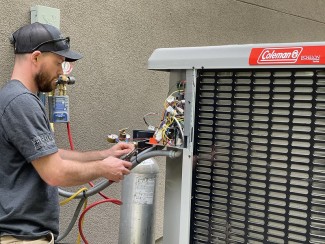Voluntary climate plans can do a little. Combined with state and local government policies, they can do a lot.
What once was an abandoned department store in downtown Racine, Wisconsin, is now a boutique hotel that is unusually good at conserving energy.
The most efficient elements of Hotel Verdant are not visible to the general public, things like a geothermal heating system underground and thick insulation beneath the roof.
But energy conservation is a crucial part of how this project came together with aid from a state-backed loan program that encourages developers to embrace energy efficiency.
“If we didn’t have those sustainable elements in the hotel, there’s no way I could have completed financing and closed on the deal,” said Christopher Adams, a Milwaukee-based developer who co-owns the property. The $8 million loan from the state made it easier for the owners to put together the rest of the financing for a project with an overall cost of about $22 million.
Hotel Verdant, which opened in August, demonstrates how a state initiative can help to mobilize a business to take actions that help the environment and the economy. It underscores findings of new research showing that state and local climate policies, combined with corporate initiatives, lead to emissions cuts that are much larger than if the companies were left to act on their own.
The paper, published in the journal Energy Research & Social Science, asks a question in the title: “Do corporate decarbonization initiatives matter as much as state and local government policy?”
The answer is a pretty clear “no,” according to the lead author, Benjamin Leffel, a professor of public policy at the University of Nevada, Las Vegas.
“Sub-national climate action and corporate climate action have a lot to gain from one another,” he said. And state and local governments can help fill the gap when the national government doesn’t have effective policies.
The paper looks at greenhouse gas reporting from CDP, the organization formerly known as the Carbon Disclosure Project, to analyze companies’ efforts on the facility level. The review covered 1,316 facilities that belonged to 184 companies in 49 states.
The results showed how significantly various factors contributed to emissions reductions.
Corporate climate initiatives had a small positive effect; city climate policies had a slightly larger positive effect; and state financial incentives for businesses had a much larger positive effect than both corporate actions and city policies.
But the best results were from combinations of corporate initiatives and both state and city policies.
This means companies that have climate policies for all their properties had an easier time making progress in places where the state or local governments had mandates, incentives or both to encourage reductions in emissions.
I should specify that corporate climate plans vary a lot, and many of them have the stink of greenwashing, which means they are more about public relations than reducing emissions. Some companies have broad plans, such as cutting emissions by a certain level by a target date. Other plans are more targeted, like initiatives to update lighting or heating, or to use more renewable energy.
When I assess the seriousness of a corporate plan, I often look for the level of detail in emissions-reduction goals and see how that compares to a company’s overall emissions. (If a company says it’s going to get to net-zero emissions by 2050, but has no interim goals and has just a one-page summary of vague strategies, it’s not a serious plan.)
One other takeaway from the report is that cities and states have much to gain by adopting climate policies. Those governments have opportunities right now, the paper said, because the Inflation Reduction Act includes big increases in funding for state and local initiatives. Cities, states and companies that already wanted to invest in renewable energy and energy efficiency can now supercharge those efforts.
The paper cites examples of state climate programs or policies in California, Colorado, Delaware, New York, Pennsylvania and Wisconsin.
Wisconsin’s policies include PACE, which stands for “property assessed clean energy,” a program that provides state-backed loans at competitive rates and with long repayment periods, among other favorable terms for borrowers. The money must be used for energy efficiency initiatives, renewable energy and water conservation.
Since 2016, the program has issued about $170 million in loans, including about $8 million to Hotel Verdant.
The hotel is located on Monument Square in the heart of the city, a few blocks from Lake Michigan. Racine, with a population of about 80,000, is just south of the Milwaukee metro area.
The building once housed Zahn’s department store, which opened in 1898. But it had been vacant for decades before this redevelopment.
“I cannot emphasize how important the PACE part was on this project,” said Adams, the developer.
His company, Dominion Properties, highlights environmentally friendly practices at its apartment buildings and other properties in and around Milwaukee. Charlestowne Hotels, a national hospitality management company, operates the hotel.
Because of the availability of the loan, his company spent more heavily on energy efficient attributes than they would have otherwise. Now, those features are leading to estimated savings of $313,000 per year on utility bills compared to what the bills would have been with a normal level efficiency, according to PACE Wisconsin.
One factor not considered in the new paper, but apparent when looking at examples like the hotel, is that energy efficiency policies have benefits that go beyond cutting emissions and savings on utility bills.
I’m thinking of the 60 or so employees at the hotel, plus the contractors that installed the energy and insulation systems, which led me to wonder how much it benefits the community.
The larger point, said Leffel, is that good things happen when companies, states and cities work in tandem to cut emissions.
“That’s when you’re really cooking,” he said.




